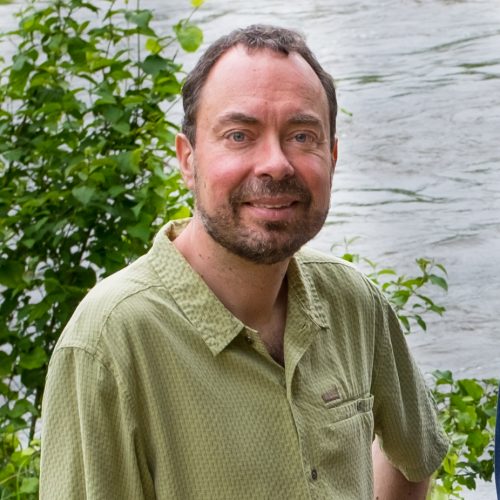Detlef Knappe
S. James Ellen Distinguished Professor

- 919-515-8791
- knappe@ncsu.edu
- Fitts-Woolard Hall 3111
Detlef Knappe is the S. James Ellen Distinguished Professor of Civil, Construction, and Environmental Engineering at NC State University. He received his BS, MS, and PhD degrees from the Department of Civil and Environmental Engineering at the University of Illinois at Urbana-Champaign, and he joined the NC State faculty in 1996. He is the Deputy Director of NC State’s Superfund Center “Environmental and Health Effects of PFAS” and is a member of the Center for Human Health and the Environment.
Dr. Knappe is interested in drinking water quality and treatment, the fate of per- and polyfluoroalkyl substances (PFAS) in natural and engineered systems, water reuse, organic micropollutants, and human exposure pathways. He is a member of the North Carolina Secretaries’ Science Advisory Board, and he serves as Associate Editor of AWWA Water Science. He also serves on the AWWA’s Organic Contaminants Research Committee and the Standards Committee for Activated Carbon.
Detlef Knappe and his students have been the recipients of numerous best paper, best poster, and best thesis awards. He is a recipient of the AWWA A. P. Black Research Award, the Borchardt-Glysson Water Treatment Innovation Prize, the Green Tie Award of the NC League of Conservation Voters, the Pelican Award of the NC Coastal Federation, an NCSU Outstanding Engagement Award, and an NCSU Outstanding Teacher Award.
Education
Environmental Engineering
University of Illinois, Urbana-Champaign
Environmental Engineering
University of Illinois, Urbana-Champaign
Civil Engineering, University of Illinois
University of Illinois, Urbana-Champaign
Research Description
Dr. Knappe's research focuses on physical-chemical water treatment processes and environmental analytical chemistry. Current research efforts include (1) developing and evaluating physical-chemical treatment processes for the control of organic micropollutants, such as per- and polyfluoroalkyl substances (PFAS), 1,4-dioxane, and pesticides, (2) assessing the fate of PFAS in natural and engineered systems, (3) identifying pathways by which people are exposed to organic micropollutants (e.g., water, diet, inhalation), and (4) overcoming gaps between the Clean Water Act and the Safe Drinking Water Act by developing information about the effects of reactive and unregulated wastewater contaminants on drinking water quality and treatment. Funding agencies that have supported or are currently supporting his research include the U.S. Environmental Protection Agency, the National Institute of Environmental Health Sciences, the National Science Foundation, the Water Research Foundation, the North Carolina Water Resources Research Institute, and the North Carolina Urban Water Consortium.
Publications
- Predicting per- and polyfluoroalkyl substances removal in pilot-scale granular activated carbon adsorbers from rapid small-scale column tests
- Hopkins, Z. R., & Knappe, D. R. U. (2024), AWWA WATER SCIENCE, 6(2). https://doi.org/10.1002/aws2.1369
- Removal of Per- and Polyfluoroalkyl substances by anion exchange resins: Scale-up of rapid small-scale column test data
- Cheng, L., & Knappe, D. R. U. (2024), WATER RESEARCH, 249. https://doi.org/10.1016/j.watres.2023.120956
- Degradation of imidacloprid by Phanerodontia chrysosporium on wood chips for stormwater treatment
- Weaver, L. M. M., Alexander, N. L., Cubeta, M. A., Knappe, D. R. U., & Aziz, T. N. (2023), ENVIRONMENTAL SCIENCE-WATER RESEARCH & TECHNOLOGY, 9(12), 3333–3343. https://doi.org/10.1039/d3ew00545c
- Estimation of the Half-Lives of Recently Detected Per- and Polyfluorinated Alkyl Ethers in an Exposed Community
- Wallis, D. J., Kotlarz, N., Knappe, D. R. U., Collier, D. N., Lea, C. S., Reif, D., … Hoppin, J. A. (2023), ENVIRONMENTAL SCIENCE & TECHNOLOGY, 57(41), 15348–15355. https://doi.org/10.1021/acs.est.2c08241
- Factors associated with per- and polyfluoroalkyl substances (PFAS) serum concentrations in residents of New Hanover County, North Carolina: The GenX exposure study
- Cuffney, M., Wilkie, A. A., Kotlarz, N., Knappe, D., Lea, C. S., Collier, D. N., … Hoppin, J. A. (2023), ENVIRONMENTAL RESEARCH, 237. https://doi.org/10.1016/j.envres.2023.117020
- Improved Darcian streambed measurements to quantify flux and mass discharge of volatile organic compounds from a contaminated aquifer to an urban stream
- Nickels, J. L., Genereux, D. P., & Knappe, D. R. U. (2023), JOURNAL OF CONTAMINANT HYDROLOGY, 253. https://doi.org/10.1016/j.jconhyd.2022.104124
- Interlaboratory Comparison of Extractable Organofluorine Measurements in Groundwater and Eel (Anguilla rostrata): Recommendations for Methods Standardization
- Ruyle, B. J., Pickard, H. M., Schultes, L., Fredriksson, F., Heffernan, A. L., Knappe, D. R. U., … Sunderland, E. M. (2023), ENVIRONMENTAL SCIENCE & TECHNOLOGY, 57(48), 20159–20168. https://doi.org/10.1021/acs.est.3c04560
- Oxidation of Per- and Polyfluoroalkyl Ether Acids and Other Per- and Polyfluoroalkyl Substances by Sulfate and Hydroxyl Radicals: Kinetic Insights from Experiments and Models
- Zhang, C., Tang, T., & Knappe, D. R. U. (2023, May 24), ENVIRONMENTAL SCIENCE & TECHNOLOGY, Vol. 5. https://doi.org/10.1021/acs.est.3c00947
- Pilot-scale biofiltration of 1,4-dioxane at drinking water-relevant concentrations
- McElroy, A. C., Ogles, M. E., Hyman, M. R., & Knappe, D. R. U. (2023), WATER RESEARCH, 231. https://doi.org/10.1016/j.watres.2023.119652
- Predicting Concentration- and Ionic-Strength-Dependent Air-Water Interfacial Partitioning Parameters of PFASs Using Quantitative Structure-Property Relationships (QSPRs)
- Stults, J. F., Choi, Y. J., Rockwell, C., Schaefer, C. E., Nguyen, D. D., Knappe, D. R. U., … Higgins, C. P. (2023, March 24), ENVIRONMENTAL SCIENCE & TECHNOLOGY, Vol. 3. https://doi.org/10.1021/acs.est.2c07316
Grants
- STC: Science and Technologies for Phosphorus Sustainability (STEPS) Center
- National Science Foundation (NSF)(10/01/21 - 9/30/26)
- Thermal Reactivation of Spent GAC from PFAS Remediation Sites
- Strategic Environmental Research and Development Program (SERDP)(12/16/20 - 12/16/25)
- Non-Targeted Analysis of PFAS Impacted Multimedia Samples to Support NCDEQ???s Action Strategy for Addressing Existing PFAS Sources and Industries with Multi-Media Impacts through Collaboration and Coordination
- NC Department of Environmental Quality (DEQ)(7/01/23 - 6/30/25)
- Center for Environmental and Health Effects of PFAS
- National Institutes of Health (NIH)(2/28/20 - 1/31/25)
- Studying the Fate of PFAS through Sewage Sludge Incinerators
- Hampton Roads Sanitation District (HRSD)(3/28/22 - 12/31/24)
- Occurrence and Fate of Per- and Polyfluoroalkyl Substances (PFAS) in North Carolina Agricultural Systems
- NC Department of Justice(1/01/21 - 12/31/24)
- Investigation of Treatment Alternatives for Short-Chain Poly- and Perfluoroalkyl Substances
- Water Research Foundation(3/01/19 - 8/01/24)
- Collaborative Research: Cyclodextrin-Based 2D Materials for the Treatment of Legacy and Emerging Perfluoroalkyl Substances
- National Science Foundation (NSF)(8/15/18 - 7/31/24)
- PFAS Transport & Exposure from DW & Diet
- US Environmental Protection Agency (EPA)(5/01/19 - 4/30/24)
- Novel Mass Spectrometry Approaches for the Identification of Pesticides and Per- and Poly-Fluoroalkyl Substances in North Carolina Drinking Water Sources
- NCSU Water Resources Research Institute(3/01/21 - 11/30/23)
